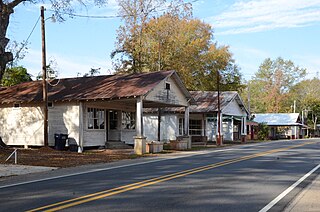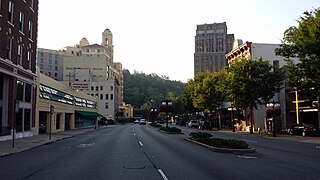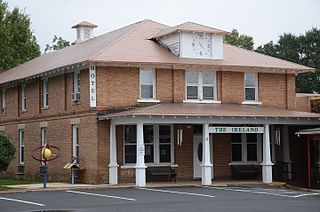
The Rusher Hotel, also known as the Great Southern Hotel, is a historic hotel building at 127 West Cedar Street in Brinkley, Arkansas. It was built in 1915 to serve the Brinkley Union Station. It is a three-story brick building, whose main entrance originally faced the railroad, but was reoriented to the street facade after the railroad declined in importance.
The University of Arkansas Campus Historic District is a historic district that was listed on the National Register of Historic Places on September 23, 2009. The district covers the historic core of the University of Arkansas campus, including 25 buildings.
Silas Owens Sr. was an African-American mason and builder in Arkansas who was noted for his distinctive style of construction. Many of the homes and buildings that Owens built are listed on the U.S. National Register of Historic Places primarily found in the Faulkner County, Arkansas area.

The Johnson House and Mill is a group of historically significant structures at 3906 Johnson Mill Boulevard in Johnson, Arkansas, USA. The house is a two-story brick building, fashioned from locally manufactured bricks, and the mill is a large 2+1⁄2-story wood-frame structure with a gable roof and large waterwheel at one end. The mill was built c. 1865-67 and the house in 1882, by Jacob Q. Johnson, the town's namesake. The complex was listed on the National Register of Historic Places. The mill building, which operated well into the 20th century, has been converted into a hotel.
The Phoenix Hotel building at 180 Main Street is the most prominent and distinctive building in downtown Rison, Arkansas. It is a two-story brick building that was built in 1913 by Dr. T. H. Ackerman to replace a previous hotel building on the site. The most distinctive feature of its facade is a basket-handled arch that frames the recessed porch on the second floor. The roof line is more elaborate than that of other downtown buildings, with corbels and brick quoins decorating the roof edge. The hotel went through a modest number of owners before closing its doors in the 1960s.

The New Edinburg Commercial Historic District encompasses the historic commercial center of New Edinburg, Arkansas. It includes ten contributing buildings lining Arkansas Highway 8, just north of its junction with Farm Market and Banks Roads. At the time of its listing on the National Register of Historic Places in 2001, all of these buildings, built between c. 1898 and 1940, stood vacant, reflecting the decline of the area.

The Hotel Massey is a former hotel in the Downtown district of Bentonville, Arkansas, built in 1910 in the Renaissance Revival architectural style. The historic property replaced the Eagle Hotel, which had been on the site since 1840. Many businesses have occupied the hotel's first floor, and the structure has contained the Bentonville Public Library twice. Coupled with Massey Hotel's community heritage, the building's architectural style is uncommon in Arkansas, and even more rare in the Ozarks. With this duality of significance, the property was added to the National Register of Historic Places in 1978.
The Ridgeway Hotel Historic District encompasses three buildings located just east of the town square of Monticello, Arkansas. The centerpiece of the district is the Ridgeway Hotel, a five-story brick building built in 1930; it is the tallest, and one of the most elaborately decorated buildings in Monticello's central business district. The district also includes 202 East Gaines Street and the H.M. Wilson Building.

The Central Avenue Historic District is the historic economic center of Hot Springs, Arkansas, located directly across Central Avenue from Bathhouse Row. Built primarily between 1886 and 1930, the hotels, shops, restaurants and offices on Central Avenue have greatly benefited from the city's tourism related to the thermal waters thought to contain healing properties. Built in a variety of architectural styles, the majority of the buildings constituting the district are two- or three-story structures. The district was listed on the National Register of Historic Places in 1985, at which time forty contributing structures were identified; 101 Park Avenue was added in 2007, and a boundary decrease was approved in 2019.

The Conway Hotel is a historic hotel building at 108 Courthouse Square in Murfreesboro, Arkansas. Built in 1913, it was the first brick hotel building in the rural town; it was built in response to an influx of diamond miners into the area after the Crater of Diamonds was discovered. It is a two-story structure with modest Craftsman styling.

The Crown Hotel, formerly the Lakeside Hotel is a historic hotel building at 119 West University Street in Siloam Springs, Arkansas. It is a two-story brick building in an L shape, with a hip roof topped by a low cupola. It is distinguished by the brickwork at the roofline, and by the delicately spindled two-story porch that wraps around two sides of the building. Built in 1881, just one year after the city's founding, it is one of the city's oldest commercial buildings, and may have been its first brick hotel.

The Hotel Seville is a historic hotel building at Vine and Ridge Streets in downtown Harrison, Arkansas. It is an L-shaped three story wood-frame structure, finished in brick and terra cotta veneer with distinctive Spanish Revival (Mission) styling. Its eastern entry porch is supported by polychrome terra cotta pillars, and portions of the exterior are finished in terra cotta tile with inset geometric patterns. Built in 1929, the building is one of the most elaborate examples of Spanish Revival architecture in the state. It was used as a hotel until the mid-1970s, when it was converted to elderly housing. It has since been converted back to a hotel.

The Mountainaire Hotel Historic District encompasses a pair of former hotel buildings at 1100 Park Avenue in Hot Springs, Arkansas. They are virtually identical four story masonry structures, clad in a buff brick veneer, with stepped facades in an Art Moderne style. They were built about 1947, as part of a planned five-building complex, and are one a small number of Art Moderne buildings in the city. They were built by A.I. Albinson, originally from Minnesota, and operated as a hotel for about twenty years. They were thereafter converted to an elderly care facility. At the time they were listed on the National Register of Historic Places in 2004, the buildings stood vacant.

The Riviera Hotel is a historic hotel building at 719 Central Avenue in Hot Springs, Arkansas. It is a five-story brick-faced structure, its main facade divided into two sections flanking a central panel. The outer sections are each topped by a rounded arch with carved foliate panels in the corner sections outside the arch. Bands of windows are separated by horizontal panels at the lower levels, and it has a commercial storefront on the ground floor. The building was designed by Charles L. Thompson and built about 1930. It is a locally significant architectural work reminiscent of the Chicago school.

The Hot Springs Federal Courthouse is located at 100 Reserve Street in Hot Springs, Arkansas. It is a three-story building, with a steel frame clad in orange brick, with porcelain panels and aluminum-clad windows. It was designed by the Little Rock firm Wittenberg, Delony & Davidson, and was built in 1959–60 on the site of the Eastman Hotel, once one of the city's largest spa hotels. It is one of the city's best examples of commercial International architecture.

The Castleberry–Harrington Historic District encompasses a collection of three mixed masonry buildings erected between 1946 and 1950 by regionally known master mason Silas Owens Sr. on Castleberry Road in rural northwestern Faulkner County, Arkansas. All are single story stone structures, built of various shades of sandstone and other materials, and were built for various members of the extended Castleberry and Harrington families. One of them has an applied herringbone pattern of stonework for which Owens was particularly well known. The three houses are located on Castleberry Road, south of the hamlet of Republican.
The Terminal Hotel is a historic commercial building at Victory and Markham Streets in Little Rock, Arkansas. It is a three-story Classical Revival brick building, set across Victory Street from Little Rock Union Station. It was built in 1905 as a railroad hotel, and has since been converted into residential housing units.

The Davidson Building is a historic building located in Sioux City, Iowa, United States. It was constructed by local businessmen and real estate developers Ben and Dave Davidson. They saw the need for an upscale office building for professionals. They hired prominent local architect William L. Steele to design the Early Commercial-style structure. It was built by the leading contractor in the city, Lytle Construction Company. Completed in 1913, it was Sioux City's first office building. The exterior of the L-shaped, six-story building is composed of terra cotta panels separated by vertical bands of Roman style brick, and capped with an ornate cornice. It is Sullivanesque in its design. Commercial space is located on the first floor, and office space occupies the upper floors. The building was listed on the National Register of Historic Places in 1999. In 2016 plans were unveiled to convert the building and the adjacent Warrior Hotel into a boutique hotel and apartments. The Davidson Building houses The Warrior Apartments, as well as 56 guest rooms for The Warrior Hotel on its second, third and fourth floors.

The Alhambra Apartments is a historic building located in Sioux City, Iowa, United States. The city experienced a building boom in 1929, and this building was constructed at that time by American Builders Incorporated of Lincoln, Nebraska. It was one of five apartment buildings built in the city that year, and based on the cost of construction it was the largest. The six-story U-shaped building rests on top of an underground parking garage. The residents could access the garage by way of an elevator. The building is composed of reinforced concrete faced with tan brick and terra cotta trim. Its design is an eclectic mix of architectural styles with Moorish influences. The Alhambra is located in a residential called the Near North-Side, just outside of the central business district. It was listed on the National Register of Historic Places in 2001.
















